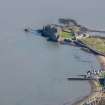Pricing Change
New pricing for orders of material from this site will come into place shortly. Charges for supply of digital images, digitisation on demand, prints and licensing will be altered.
Blackness, Pier
Pier (Period Unassigned)
Site Name Blackness, Pier
Classification Pier (Period Unassigned)
Alternative Name(s) Blackness Pier
Canmore ID 49498
Site Number NT08SE 33.01
NGR NT 05173 80122
Datum OSGB36 - NGR
Permalink http://canmore.org.uk/site/49498
- Council Falkirk
- Parish Bo'ness And Carriden
- Former Region Central
- Former District Falkirk
- Former County West Lothian
NT08SE 33.01 05173 80122
Location formerly cited as NT 0518 8010.
Pier [NAT]
OS 1:10,000 map, 1975.
EXTERNAL REFERENCE: NATIONAL ARCHIVES OF SCOTLAND (SRO)
Additions to the Pier. John Chalmers, Architect, acts as a cautioner for William Shaw, Mason, in the lawsuit between Shaw and a committee of the inhabitants.
1793 GD 124/6/304.
(Undated) information in NMRS.
(Location cited as NT 052 801). Blackness, West Lothian. Blackness was a landing-place at least as early as 1304, and in 1389 the 'port' was granted to the Royal Burgh of Linlithgow. In 1465 the burgh was authorised to build a harbour there, with permission to take stones and lime for that purpose from the castle (NT08SE 6.00), the demolition of which was ordered at the same time. The area granted for the port comprised the whole promontory ('montem et rupem') of Blackness to the N of St Ninian's Chapel (NT08SE 10), the site of which is marked on OS maps at the NE end of the village (NT07NE 108), and extending to high-water mark on either side, but it unnecessary to infer that the inclusion of the E side of the promontory implies a connection with the remains noted in the bay to the S of Blackness Castle (NT08SE 6.00), seeing that the village and the custom-house (NT08SE 55), as well as St Ninian's Chapel (NT08SE 10 ), are all on the W bay. 'Biging and reparatioun of the schore and hewin' were in progress in 1602-4, and in 1710 the place had 'a harbour for all Ships', with a custom-house and warehouses, and ranked as the only safe anchorage in that part of the Firth. Roy's map (1747-55) marks a pier very much in the position of the existing one, but the latter is evidently not the same one as was standing in his day as the harbour was in ruins by 1843, and in 1856the 25-in OS map marked nothing more than an ill-defined rickle of stones, all below high-water mark. It is only in the edition of 1895 that the pier is given its present form, and its rough irregular masonry, combined with the cemented top and remains of timber fenders, suggests quite recent construction. However, the pier's present length of 220ft [67.1m] may be approximately the same as that of the earlier work; and some of the latter's materials may well have been re-used, particularly the very large boulders on which the seaward end is founded. The structure is now partly ruinous.
A Graham 1971.
The pier is located west of Blackness Castle (NT08SE 6.00). The stone pier is c 20m long and is still in use. It is marked on the 1st edition OS map.
Site recorded by GUARD during the Coastal Assessment Survey for Historic Scotland, 'The Firth of Forth from Dunbar to the Coast of Fife' 24th February 1996.
This available map ewvidence (OS AIB GIS) indicates that this pier extends from NT 05173 80122 to NT c. 05181 80087. It is extensively used by the local sailing club.
Information from RCAHMS (RJCM), 30 March 2006.
















